A Numerical Study of the Behavior of Micropile Foundations under Cyclic Thermal Loading
Abstract
:1. Introduction
2. Basis for Numerical Analyses
2.1. Geometry
2.2. Material Thermal and Mechanical Properties
2.3. Initial and Boundary Conditions and Modeling Sequence
- The problem domain was initialized with an initial stress phase, based on a value of the at-rest earth pressure coefficient, K0 of 0.429, and an initial temperature, T0 of 14 °C;
- Recognizing that the near-surface region of the ground is influenced by seasonal climate variations, in this stage, a transient thermal analysis was undertaken in order to establish the extent of this region. To achieve this, a periodic temperature function, Equation (2) and Figure 3a, was applied at the ground surface over a period of 10 years, which was found to be sufficient to establish a dynamic thermal equilibrium with the imposed boundary condition, Figure 3b.
- The pile was wished-in-place and then the allowable service load, Fa (see Section 3.1.1) was applied;
- Operational thermal activation of the pile was then modeled for a duration of 10 years, through a “coupled temperature-displacement (transient)” procedure. This was achieved by applying a periodic temperature change over the length of the pile, on the centerline of the micropile. This approach was considered reasonable following the work of [29] which found that thermal load applied as a temperature at the pipe position in a micropile gave similar responses to that obtained by modeling the pipe flow using one-dimensional, forced-convection elements.
- An “outside” condition, as described above was maintained to represent an outdoor environmental condition which would be consistent with, e.g., the running of a pile load test;
- An “inside” condition was modeled, again using Equation (2) but with Tavg = 23 °C, ΔT = 2 °C and P = 1, Figure 3a, which represents the indoor thermal comfort condition for a structure supported on the pile foundation.
3. Results and Discussion
3.1. Mechanical Behavior
3.1.1. Load-Displacement Response of an Isolated Pile
3.1.2. Pile–Soil–Pile Interaction under Mechanical Load
3.2. Thermal Fields for Isolated Pile and Group Unit Cell
3.3. Thermo-Mechanical Behavior
3.3.1. Isolated Micropile and Group Unit Cell Response
- (a)
- Pile axial thermal displacement
- (b)
- Pile axial thermal stress
3.3.2. Influence of Surface Temperature Boundary Condition
- (a)
- MP-15
- (b)
- MP-30
3.4. Heat Transfer
3.5. Comparison with Previous Studies
- (a)
- Isolated piles (R/D = 30)
- (b)
- Pile group (unit cell with R/D = 4)
4. Conclusions
- At the applied service load, which was based on a factor of safety of 2 on shaft resistance, the mobilization factor, M, describing the proportion of shaft resistance mobilized relative to the maximum available shaft resistance, was around 50%. In the cases involving reduced pile spacing, the pile–soil–pile interactions led to M reducing further by about 5%. In an associated study examining large diameter piles, it was established that having M less than 80% was necessary to ensure the response to thermal loading was quasi thermo-elastic;
- Under cyclic thermal loading, an irrecoverable settlement developed in the first few cycles; the values were small, however, and are unlikely to be important in design terms. This initial settlement occurred in the first cooling cycles and was due to reductions in horizontal stress and, thus, available shaft resistance, as the pile contracted. The mobilized shaft and base resistances quickly adjusted to rebalance this effect and subsequent pile head displacements were thermo-elastic. The associated thermal stress changes also quickly stabilized having been modified by the initial alterations in the mobilized shaft and base resistance, discussed above. This stable response was due to the low initial mobilization (M < 50%) of the available shaft resistance;
- This study highlights another important issue related to the slenderness and axial stiffness of the TA pile; in this case, the initial response of the micropile to the thermal cycles resulted in large compression stresses being locked-in, which in the case of an isolated pile, led to stresses in excess of the value for perfect thermal restraint—in this case, about 60% higher. This effect should be carefully considered when long, slender TA piles are planned to be used;
- The results presented from this study illustrate the potential for using micropiles in SGE systems. It is clear that with a design based only on the shaft resistance and factors of safety typically used for micropile design (around 2.0), the thermo-mechanical response should be stable in the long term. Again, if long, slender piles are to be used, then attention should be paid to the thermal stress changes that could develop and, in all cases, especially in closely spaced groups, cyclic pile head movements should be verified against the allowable movement limits specified for the project. These findings are not applicable for micropiles used as settlement reducing type piles, with high initial mobilization of the available shaft resistance;
- The introduction of a surface temperature boundary condition representing an air-conditioned building supported by a pile foundation, resulted in an axial thermal tension load developing at the pile head and elsewhere within the pile body. This was due to the general warming of the ground near the surface which created an underlying tensile response, onto which was superimposed additional thermal tension due to cyclic thermal operation of the micropile. In the cases studied here however, at no time did the pile thermo-mechanical axial stress stray into tension;
- Heat exchange for cooling was found to be compromised by the surface boundary condition imposed by a climate-controlled structure supported by the piles, while heating potential was enhanced as the heat losses from the overlying structure were “recycled”. Absolute pile spacing is also important for heat exchange potential, as thermal interference leads to reduced potential in closely spaced piles, and at the closest spacing considered herein, resulted in a significant loss of function. This is an issue that requires further study, to optimize TA micropile layouts to ensure correct functioning of the SGE system.
Author Contributions
Funding
Institutional Review Board Statement
Informed Consent Statement
Data Availability Statement
Acknowledgments
Conflicts of Interest
References
- Cotana, F.; Belardi, P.; Manciola, P.; Tamagnini, C.; Materazzi, A.L.; Fornaciari, M.; Petrozzi, A.; Pisello, A.L.; Cavalaglio, G.; Coccia, V.; et al. TIAR: Renewable energy production, storage and distribution; a new multidisciplinary approach for the design of rural facility. Energy Procedia 2014, 45, 323–332. [Google Scholar] [CrossRef]
- Brandl, H. Energy foundations and other thermo-active ground structures. Géotechnique 2006, 56, 81–122. [Google Scholar] [CrossRef]
- Di Donna, A.; Barla, M.; Amis, T. Energy Geostructures: Analysis from Research and Systems Installed around the World. In Proceedings of the 42nd Annual Conerence. on Deep Foundations, New Orleans, LA, USA, 24–27 October 2017. [Google Scholar]
- Bernardi, A.; Pockelé, L.; Sanner, B.; Cicolin, F.; De Carli, M.; Galgaro, A.; Urchueguía, J.; Mezzasalma, G.; Pasquali, R.; Poletto, F.; et al. Innovative drilling methods, heat pumps and tools to address shallow geothermal in the built environment: H2020 project—GEO4CIVHIC. In Proceedings of the European Geothermal Conference, Den Haag, The Netherlands, 11–14 June 2019. [Google Scholar]
- Uotinen, V.M.; Repo, T.; Vesamäki, H. Energy piles—Ground energy system integrated to the steel foundation piles. In Proceedings of the 16th Nordic Geotechnical Meeting, Copenhagen, Denmark, 9–12 May 2012. [Google Scholar]
- Tyszer, M.; Tomaszewska, B. Evaluation of the Possibility of Use Geothermal Energy Micropiles TITAN 73/53 to Obtain Low-Temperature Heat Energy Accumulated in the Near-Surface Layers of the Ground in Poland Area. In Renewable Energy Sources: Engineering, Technology, Innovation; Mudryk, K., Werle, S., Eds.; Springer Proceedings in Energy; Springer: Cham, Germany, 2018. [Google Scholar]
- Lautkankare, R.; Sarola, V.; Kanerva-Lehto, H. Energy piles in underpinning projects—Through holes in load transfer structures. J. Deep. Found. Inst. 2014, 8, 3–14. [Google Scholar] [CrossRef]
- EN 14199:2005; Execution of Special Geotechnical Works-Micropiles. BSI: London, UK, 2005.
- Bruce, D.A.; Dimillio, A.; Juran, I. Micropiles: The state of practice. Part I: Characteristics, definitions and classifications. Ground Improv. 1997, 1, 25–35. [Google Scholar] [CrossRef]
- Lizzi, F. “Pali radice” structure. In Underpinning and Retention; Thorburn, S., Littlejohn, G.S., Eds.; Blackie Academic & Professional: Glasgow, UK, 1993. [Google Scholar]
- Rotta Loria, A.F.; Vadrot, A.; Laloui, L. Analysis of the vertical displacement of energy pile groups. Geomech. Energy Environ. 2018, 16, 1–14. [Google Scholar] [CrossRef]
- Mohamad, Z.; Fardoun, F.; Meftah, F. A review on energy piles design, evaluation, and optimization. J. Clean. Prod. 2021, 292, 125802. [Google Scholar] [CrossRef]
- Liu, S.W.; Zhang, Q.Q.; Cui, W.; Liu, G.H.; Liu, J.H. A simple method for analyzing thermomechanical response of an energy pile in a group. Geomech. Energy Environ. 2022, 32, 100309. [Google Scholar] [CrossRef]
- Lupattelli, A.; Cernuto, E.; Brunelli, B.; Cattoni, E.; Salciarini, D. Experimentation of the Thermo-Mechanical Behavior of the Soil-Concrete Interface. In Springer Series in Geomechanics and Geoengineering; Springer: Berlin/Heidelberg, Germany, 2023; pp. 343–350. [Google Scholar]
- Salciarini, D.; Cecinato, F. Numerical Modelling of Thermo-active Micropiles. Lect. Notes Civ. Eng. 2021, 126, 1102–1109. [Google Scholar]
- Gerola, M.; Lupattelli, A.; Cecinato, F.; Salciarini, D.; Arola, T. Numerical Analysis of the Behaviour of Energy Micropiles Used for Heat Storage: A Case Study in Turku (Finland). In Springer Series in Geomechanics and Geoengineering; Springer: Berlin/Heidelberg, Germany, 2023; pp. 808–815. [Google Scholar]
- Akrouch, G.A.; Sánchez, M.; Briaud, J.L. Thermo-mechanical behavior of energy piles in high plasticity clays. Acta Geotech. 2014, 9, 399–412. [Google Scholar] [CrossRef]
- Alberdi-Pagola, M.; Lund Jensen, R.; Erbs Poulsen, S. A performance case study of energy pile foundation at Rosborg Gymnasium (Denmark), in CLIMA 2016. In Proceedings of the 12th REHVA World Congress, Aalborg, Denmark, 22–25 May 2016. [Google Scholar]
- Hamada, Y.; Saitoh, H.; Nakamura, M.; Kubota, H.; Ochifuji, K. Field performance of an energy pile system for space heating. Energy Build. 2007, 39, 517–524. [Google Scholar] [CrossRef]
- Jalaluddin, J.; Miyara, A.; Tsubaki, K.; Yoshida, K. Thermal performances of three types of ground heat exchangers in short-time period of operation. In Proceedings of the International Refrigeration and Air Conditioning Conference, West Lafayette, IN, USA, 12–15 July 2010. [Google Scholar]
- Katsura, T.; Nakamura, Y.; Okawada, T.; Saeki, E.; Nakamura, Y.; Okamoto, A.; Narita, S. Field test on heat extraction or injection performance of energy piles and its application. In Proceedings of the 11th International Conference on Thermal Energy Storage, Stockholm, Sweden, 14–17 June 2009. [Google Scholar]
- Nagano, K.; Katsura, T.; Takeda, S.; Saeki, E.; Nakamura, Y.; Okamoto, A.; Narita, S. Thermal characteristics of steel foundation piles as ground heat exchangers. In Proceedings of the 8th IEA Heat Pump Conference, Las Vegas, NV, USA, 30 May–2 June 2005. [Google Scholar]
- Ronchi, F.; Salciarini, D.; Cavalagli, N.; Tamagnini, C. Thermal response prediction of a prototype Energy Micro-Pile. Geomech. Energy Environ. 2018, 16, 64–82. [Google Scholar] [CrossRef]
- Ren, L.-W.; Xu, J.; Kong, G.Q.; Liu, H.L. Field tests on thermal response characteristics of micro-steel-pipe pile under multiple temperature cycles. Renew. Energy 2020, 147, 1098–1106. [Google Scholar] [CrossRef]
- Kong, G.; Cao, T.; Hao, Y.; Zhou, Y.; Ren, L. Thermomechanical properties of an energy micro pile-raft foundation in silty clay. Undergr. Space 2019, 6, 76–84. [Google Scholar] [CrossRef]
- Alberdi-Pagola, M.; Madsen, S.; Lund Jensen, R.; Erbs Poulsen, S. Numerical investigation on the thermo-mechanical behavior of a quadratic cross section pile heat exchanger. In Proceedings of the IGSHPA Technical/Research Conference and Expo, Denver, CO, USA, 14–16 March 2017. [Google Scholar]
- Hassani Nezhad Gashti, E.; Uotinen, V.M.; Kujala, K. Numerical modelling of thermal regimes in steel energy pile foundations: A case study. Energy Build. 2014, 69, 165–174. [Google Scholar] [CrossRef]
- Hassani Nezhad Gashti, E.; Uotinen, V.M.; Kujala, K. Evaluation of thermo-mechanical behaviour of composite energy piles during heating/cooling operations. Eng. Struct. 2014, 75, 363–373. [Google Scholar] [CrossRef]
- Skordas, D.; Bodas Freitas, T.M.; Borne-Webb, P.J.; Georgiadis, K. Modelling of thermally-activated bored micropiles for provision of renewable heating & cooling in buildings. In Proceedings of the International Conference on Construction, Energy, Environment & Sustainability, Coimbra, Portugal, 12 October 2021. [Google Scholar]
- Bourne-Webb, P.J. Observed Response of Energy Geostructures. In Energy Geostructures; Laloui, L., Di Donna, A., Eds.; John Wiley & Sons, Inc.: Hoboken, NJ, USA, 2013. [Google Scholar]
- Loveridge, F.; McCartney, J.S.; Narsilio, G.A.; Sanchez, M. Energy geostructures: A review of analysis approaches, in situ testing and model scale experiments. Geomech. Energy Environ. 2020, 22, 100173. [Google Scholar] [CrossRef]
- Cecinato, F.; Salciarini, D. Energy performance assessment of thermo-active micro-piles via numerical modeling and statistical analysis. Geomech. Energy Environ. 2021, 29, 100268. [Google Scholar] [CrossRef]
- Garbellini, C.; Laloui, L. Thermal stress analysis of energy piles. Géotechnique 2019, 71, 260–271. [Google Scholar] [CrossRef]
- Bourne-Webb, P.J.; Lupattelli, A.; Bodas Freitas, T.M.; Salciarini, D. The influence of initial shaft resistance mobilisation in the response of seasonally thermally-activated pile foundations in granular media. Geomech. Energy Environ. 2022, 30, 100299. [Google Scholar] [CrossRef]
- ABAQUS Simulia, Abaqus 2016 Software Documentation; Dassault Systèmes; Dassault Systèmes Simulia Corp.: Providence, RI, USA, 2016.
- Zito, M. Transient Analysis of Building-Pile-Soil Interactions in Thermally-Activated Foundations. Master’s Thesis, Civil Engineering, Politecnico di Milano, Milano, Italy, 2019. [Google Scholar]
- Jenck, O.; Dias, D.; Kastner, R. Three-Dimensional Numerical Modeling of a Piled Embankment. Int. J. Geomech. 2009, 9, 102–112. [Google Scholar] [CrossRef]
- Tschuchnigg, F.; Schweiger, H.F. Comparison of Deep Foundation Systems using 3D Finite Element Analysis Employing Different Modeling Techniques. Geotech. Eng. J. SEAGS AGSSEA 2013, 44, 40–46. [Google Scholar]
- Ng, K.S.; Tan, S.A. Stress Transfer Mechanism in 2D and 3D Unit Cell Models for Stone Column Improved Ground. Int. J. Geosynth. Ground Eng. 2014, 1, 3. [Google Scholar] [CrossRef]
- Barker, C.A. Behaviour of sand: An Investigation of Bochum Sand. Master’s Thesis, Imperial College, London, UK, 2001. [Google Scholar]
- Leroueil, S.; Hight, D.W. Behaviour and Properties of Natural Soils and Soft Rocks. In Characterisation and Engineering Properties of Natural Soils; CRC Press: London, UK, 2003. [Google Scholar]
- Jefferies, M.G.; Shuttle, D.A. NORSAND—Features Calibration & Use. In Soil Constitutive Models: Evaluation, Selection, and Calibration; GSP 128; American Society of Civil Engineers: Reston, VA, USA, 2005; pp. 204–236. [Google Scholar]
- Gawecka, K.A.; Taborda, D.M.G.; Potts, D.M.; Cui, W.; Zdravkovi, L.; Kasri, M.S.H. Numerical modelling of the thermos-active piles in London Clay. ICE Proc. Geotech. Eng. 2017, 170, 201–219. [Google Scholar] [CrossRef]
- Rotta Loria, A.F.; Donna, A.D.; Laloui, L. Numerical Study on the Suitability of Centrifuge Testing for Capturing the Thermal-Induced Mechanical Behavior of Energy Piles. J. Geotech. Geoenviron. Eng. 2015, 141, 04015042. [Google Scholar] [CrossRef]
- Rotta Loria, A.F.; Gunawan, A.; Shi, C.; Laloui, L.; Ng, C.W.W. Numerical Modelling of Energy Piles in Saturated Sand Subjected to Thermo-Mechanical Loads. Geomech. Energy Environ. 2015, 1, 1–15. [Google Scholar] [CrossRef]
- Han, J.; Liu, L.; Zuo, C.; Wang, H.; Lin, F.; Zhao, Y.; Li, T.; Liu, D. Evolution and Parametric Analysis of Concrete Temperature Field Induced by Electric Heating Curing in Winter. Sustainability 2023, 15, 8337. [Google Scholar] [CrossRef]
- Naus, D.J. A Compilation of Elevated Temperature Concrete Material Property Data and Information for Use in Assessments of Nuclear Power Plant Reinforced Concrete Structures; (No. ORNL/TM-2009/175); Oak Ridge National Laboratory: Oak Ridge, TN, USA, 2010. [Google Scholar]
- Allan, M.L.; Philippacopoulos, A.J. Thermally Conductive Cementitious Grouts for Geothermal Heat Pumps. Progress Report FY 1998; (Informal No. BNL-66103); Brookhaven National Laboratory: Upton, NY, USA, 1998. [Google Scholar]
- Lim, J.K.; Lehane, B. Shearing resistance during pile installation in sand. ICE Proc. Geotech. Eng. 2015, 168, 168–235. [Google Scholar] [CrossRef]
- Vieira, A.; Alberdi-Pagola, M.; Barla, M.; Christodoulides, P.; Florides, G.; Insana, A.; Javed, S.; Maranha, J.; Milenic, D.; Prodan, I.; et al. Site characterization for the design of thermoactive geostructures. Soils Rocks 2022, 45, e2022001022. [Google Scholar] [CrossRef]
- Fleming, W.G.K. Piling Engineering, 3rd ed.; Taylor & Francis: London, UK; New York, NY, USA, 2009. [Google Scholar]
- Fuentes, R.; Pinyol, N.; Alonso, E. Effect of temperature induced excess porewater pressures on the shaft bearing capacity of geothermal piles. Geomech. Energy Environ. 2016, 8, 30–37. [Google Scholar] [CrossRef]
- Joshaghani, M.; Ghasemi-Fare, O. Exploring the effects of temperature on intrinsic permeability and void ratio alteration through temperature-controlled experiments. Eng. Geol. 2021, 293, 106299. [Google Scholar] [CrossRef]
- Tatro, S.B. Thermal Properties (of Concrete). In Significance of Tests and Properties of Concrete and Concrete-making Materials; Lamond, J.F., Pielert, J.H., Eds.; ASTM International: West Conshohocken, PA, USA, 2006; pp. 226–237. [Google Scholar]
- Côté, J.; Konrad, J.-M. A Generalized Thermal Conductivity Model for Soils and Construction Materials. Can. Geotech. J. 2005, 42, 443–458. [Google Scholar] [CrossRef]
- Juran, I.; Bruce, D.A.; Dimillio, A.; Benslimane, A. Micropiles: The state of practice. Part II: Design of single micropiles and groups and networks of micropiles. Ground Improv. 1999, 3, 89–110. [Google Scholar] [CrossRef]
- FHWA. Micropile Design and Construction; Publ. No. FHWA NHI-05-039; National Highway Institute: Washington, DC, USA, 2005. [Google Scholar]
- BS EN 1997-1:2004+A1:2013; Eurocode 7. Geotechnical Design—General Rules. BSI: London, UK, 2005.
- Bodas Freitas, T.M.; Zito, M.; Bourne-Webb, P.J.; Sterpi, D. Thermal performance of seasonally, thermally-activated floating pile foundations in a cohesive medium. Eng. Struct. 2021, 243, 112588. [Google Scholar] [CrossRef]
- Poulos, H.G. Analysis of the settlement of pile groups. Géotechnique 1968, 18, 449–471. [Google Scholar] [CrossRef]
- Poulos, H.G. Group factors for pile-deflection estimation. ASCE J. Geotech. Eng. Div. 1979, 105, 1489–1509. [Google Scholar] [CrossRef]
- Bourne-Webb, P.J.; Bodas Freitas, T.M.; Zito, M.; Lupattelli, A.; Sterpi, D.; Salciarini, D. Outstanding issues in understanding the behaviour of thermally-activated pile foundations. In Proceedings of the DFI EFFC International Conference on Deep Foundations and Ground Improvements, Berlin, Germany, 18–20 May 2022. [Google Scholar]
- Bourne-Webb, P.J.; Bodas Freitas, T.M.; Freitas Assunção, R.M. A review of pile-soil interactions in isolated, thermally-activated piles. Comput. Geotech. 2019, 108, 61–74. [Google Scholar] [CrossRef]
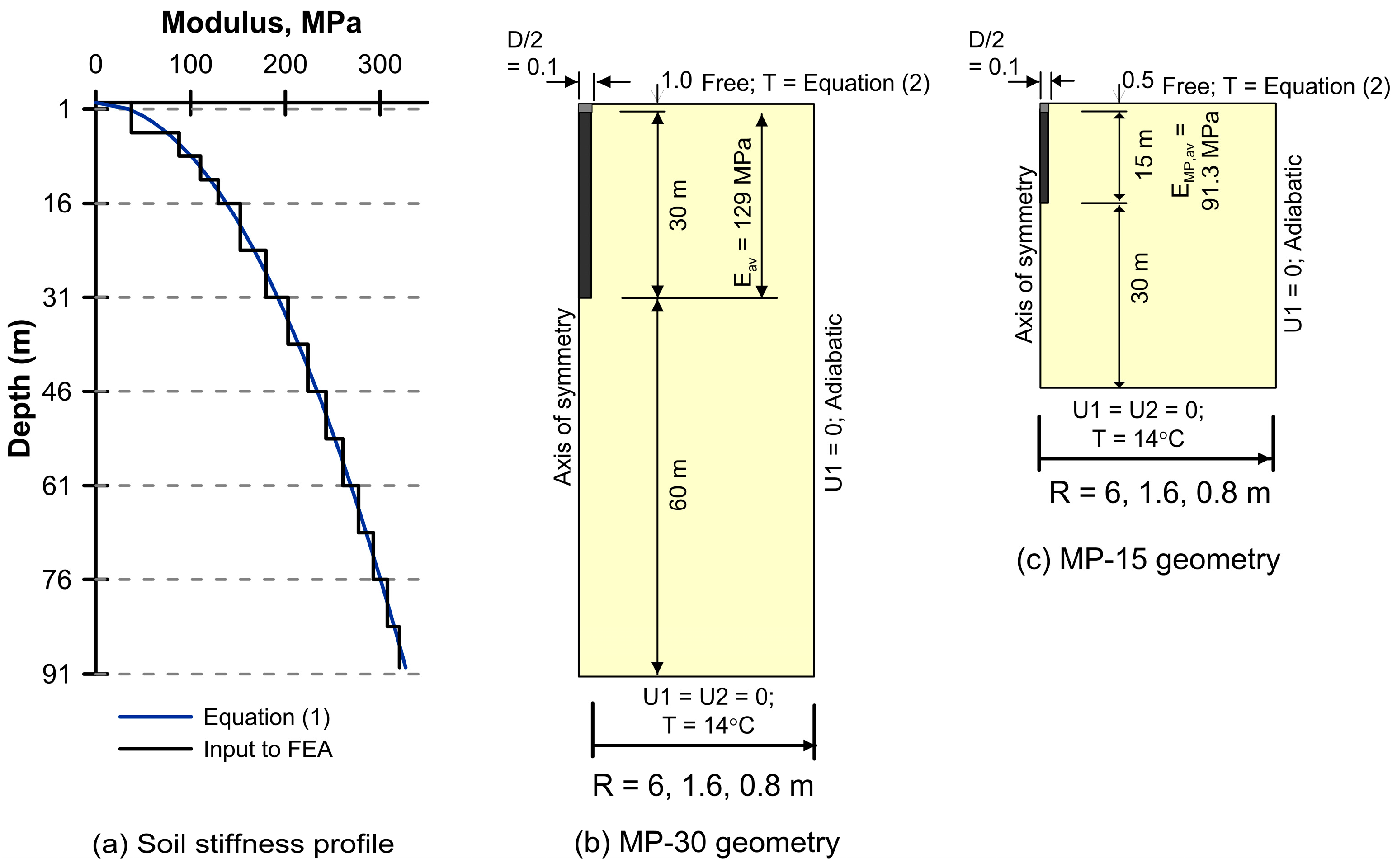

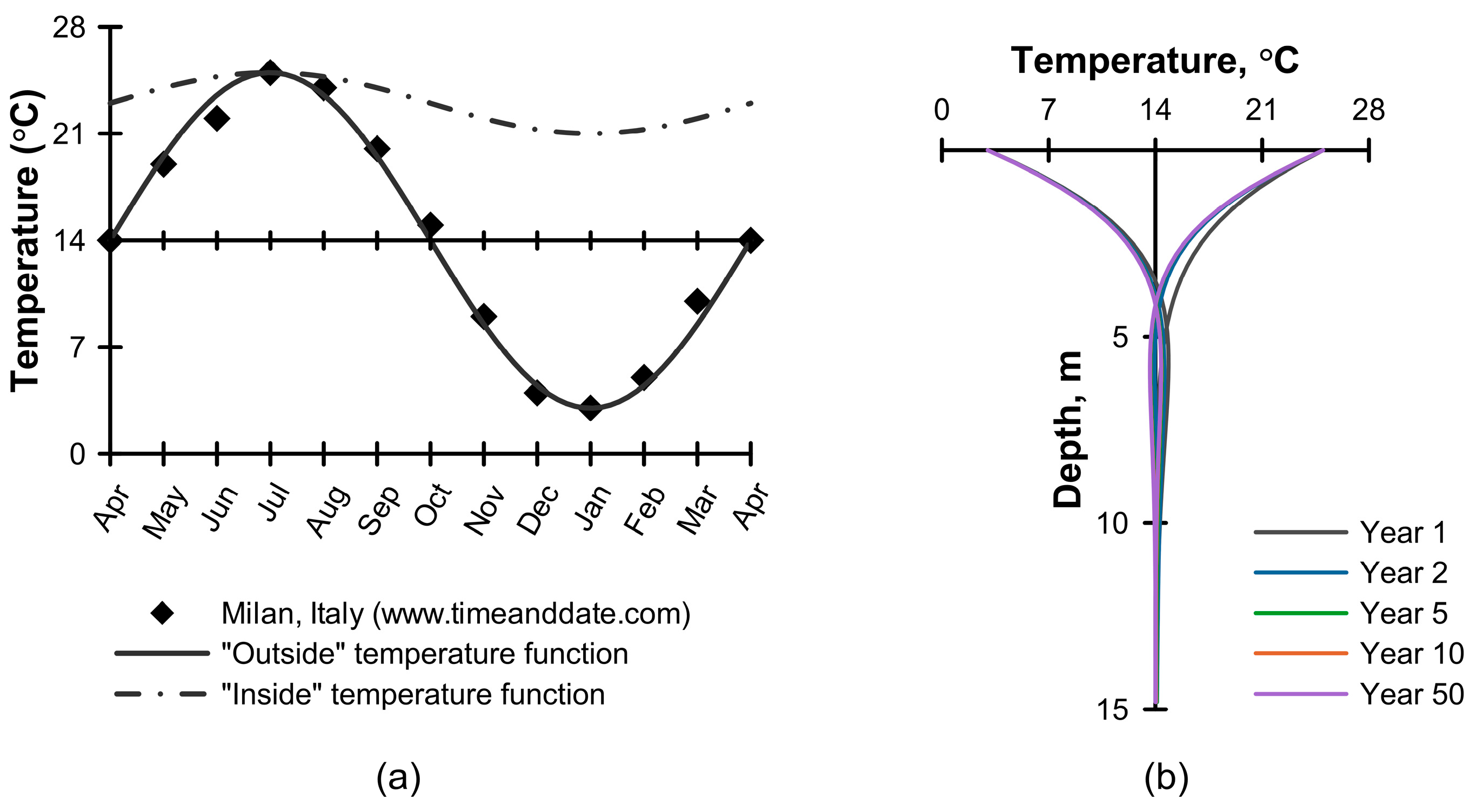
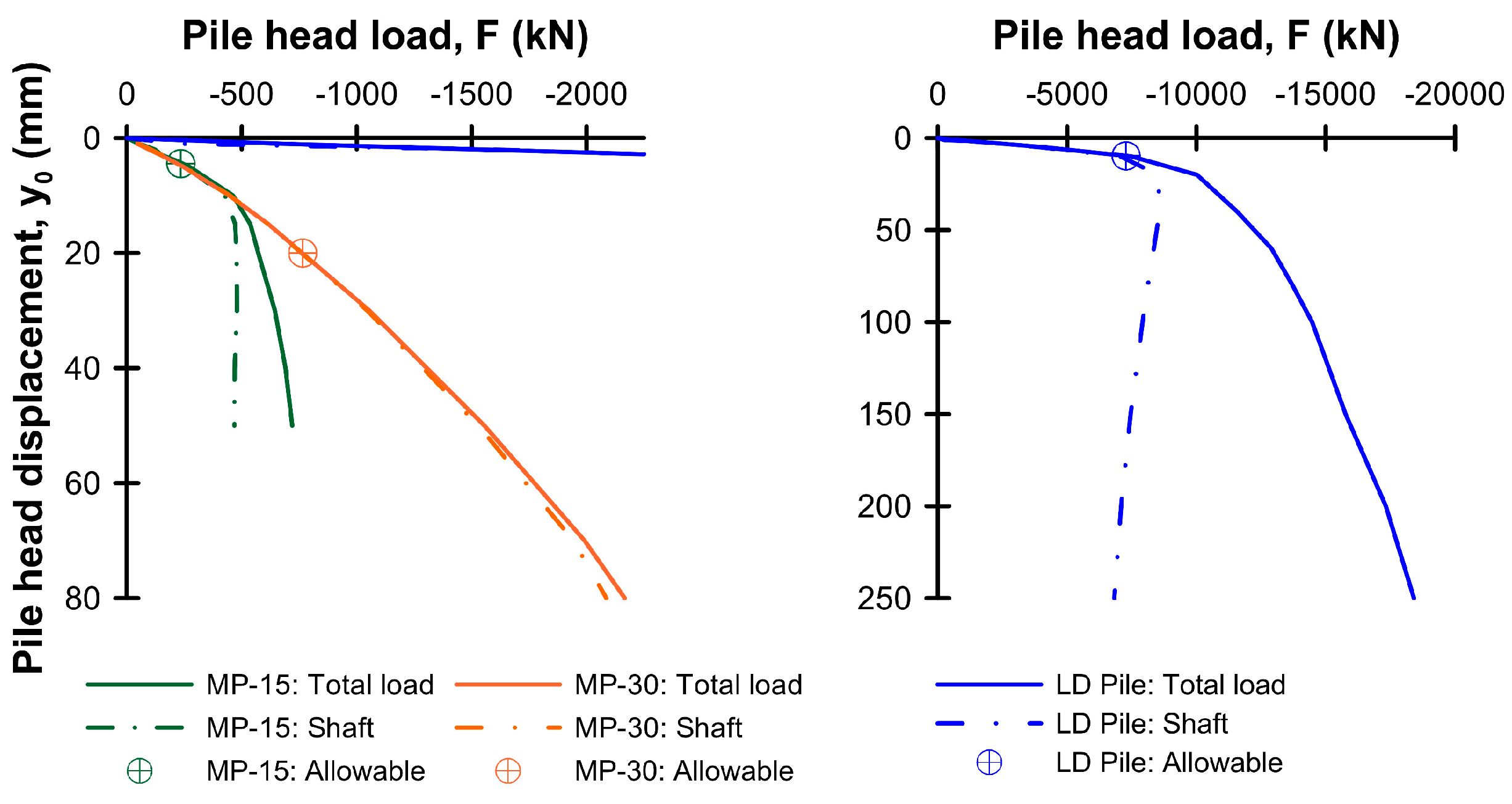


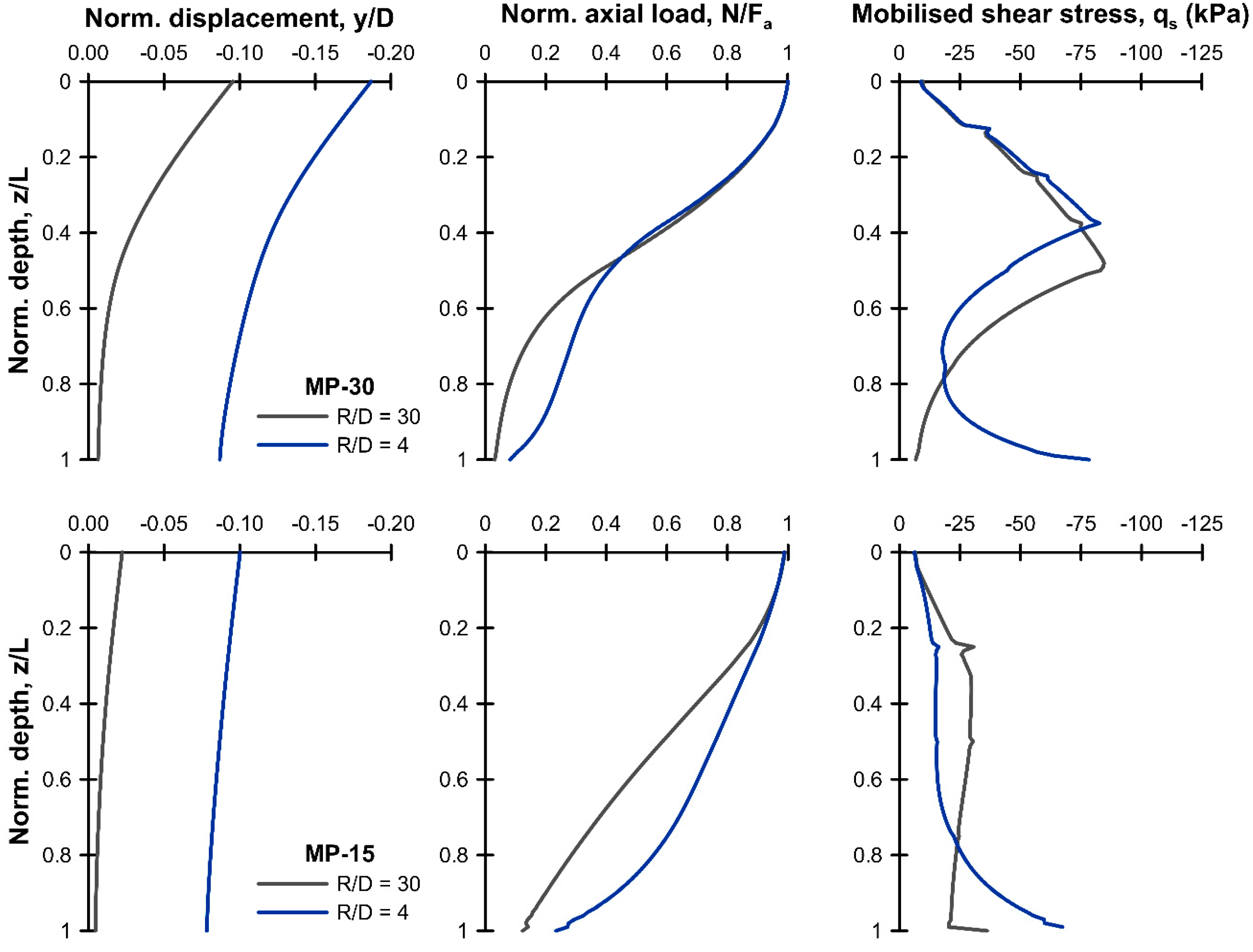
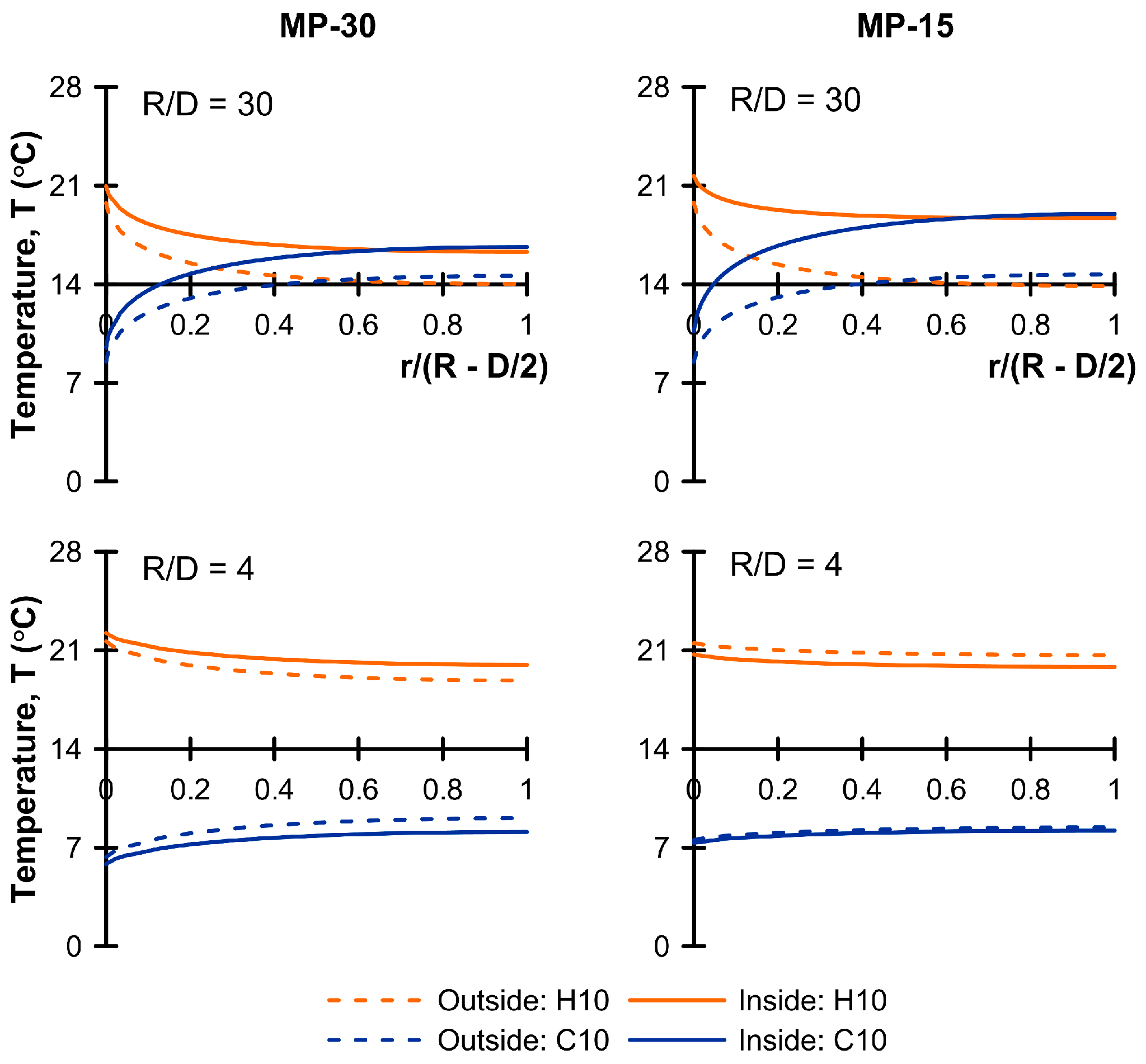


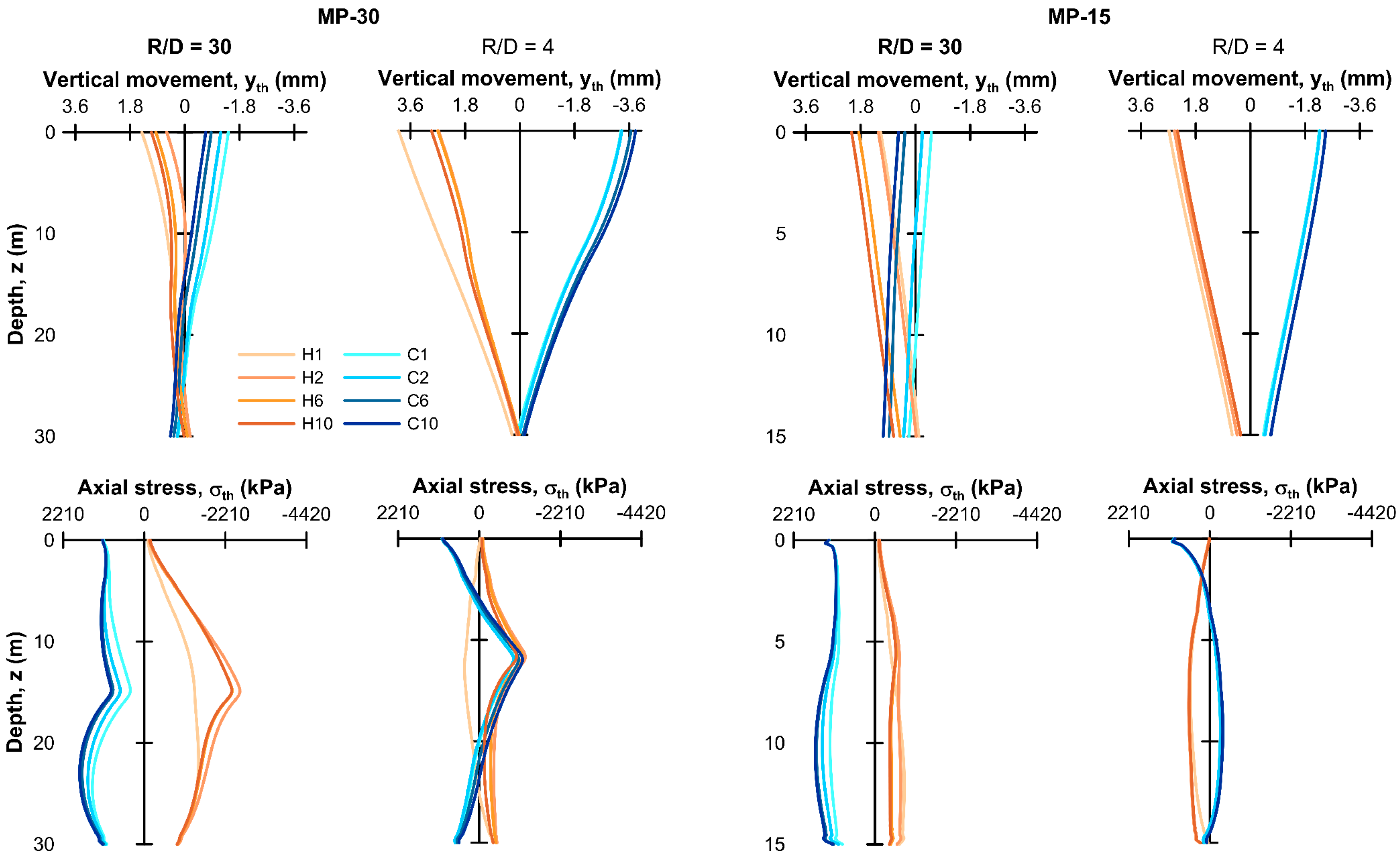
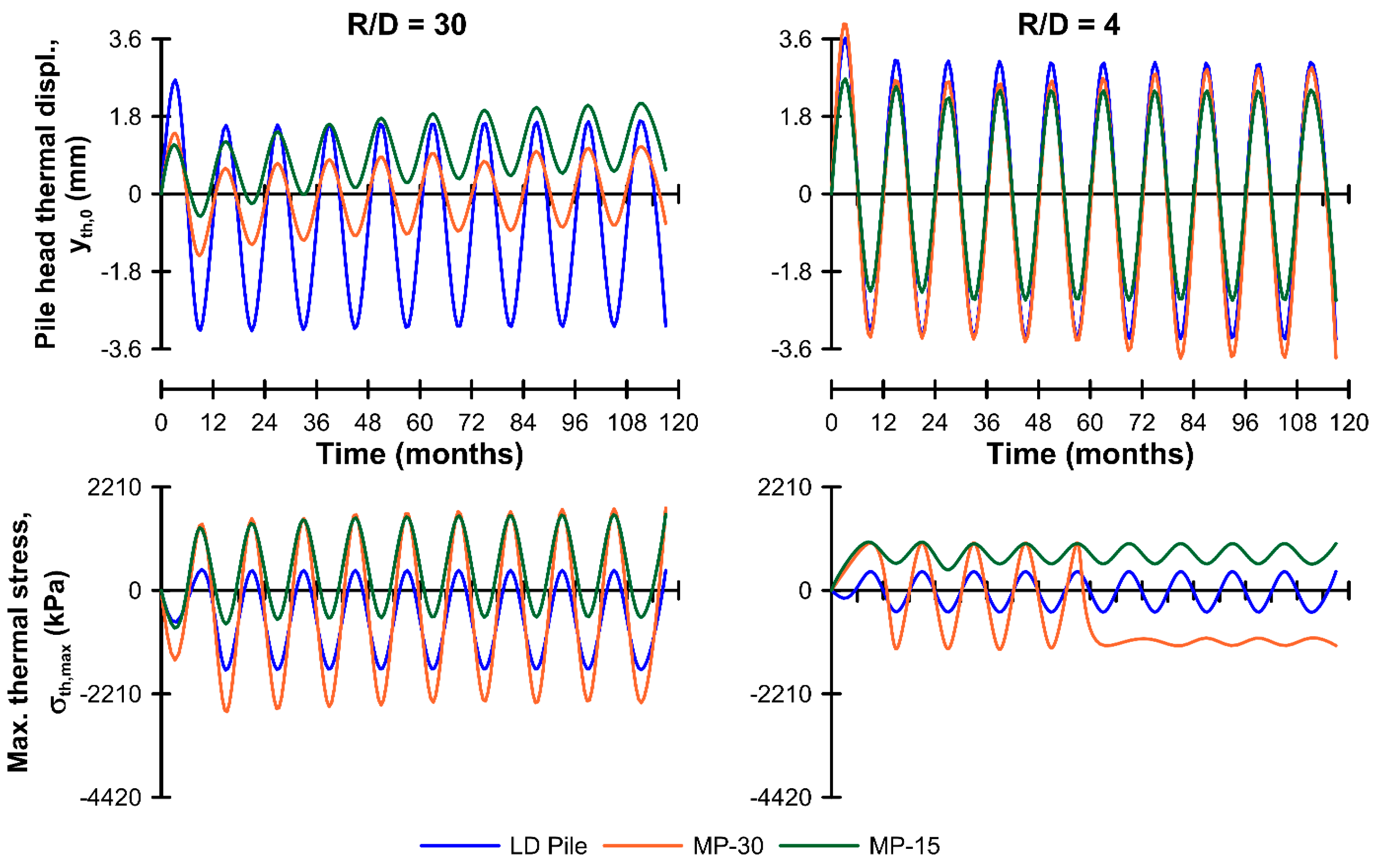
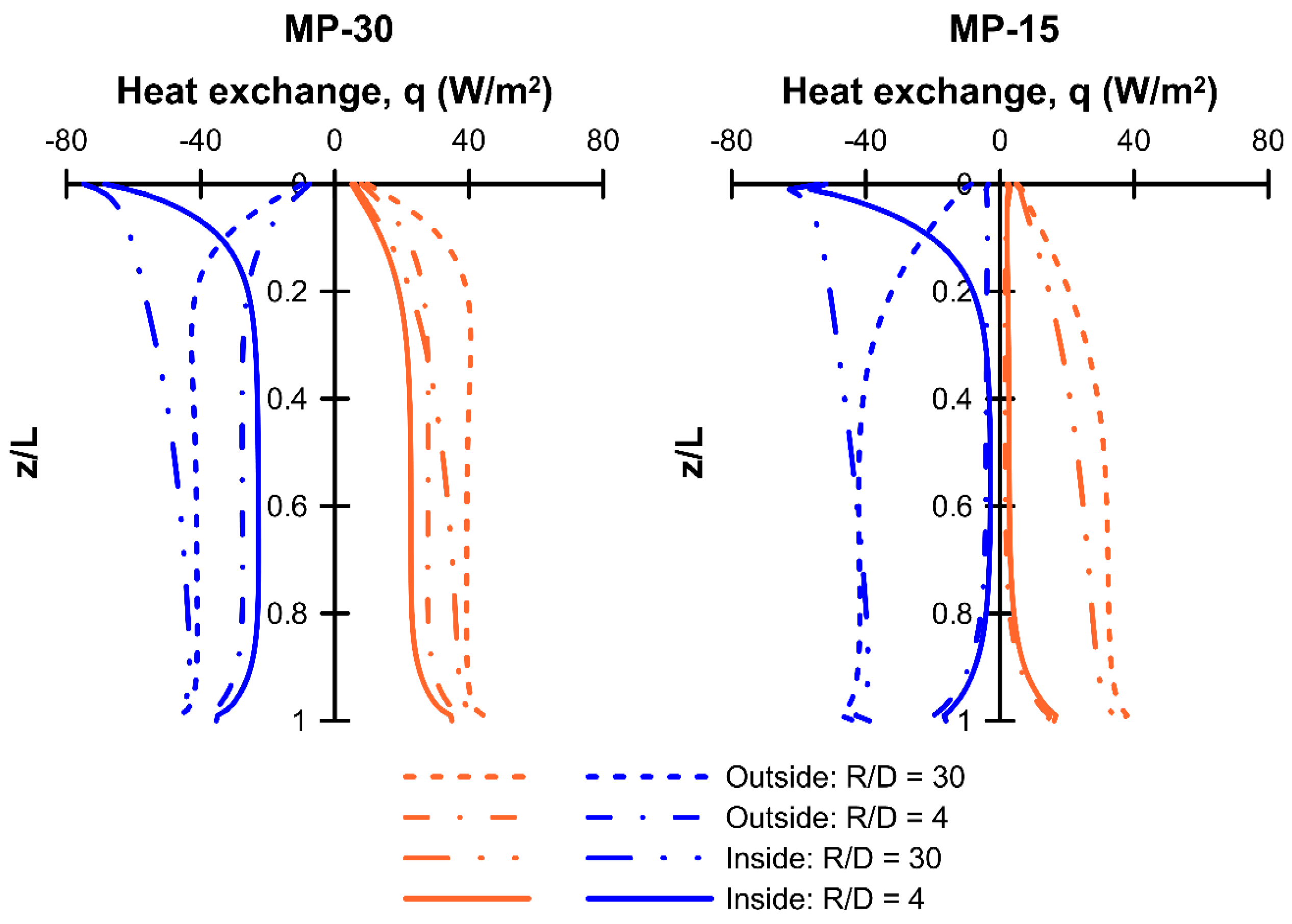
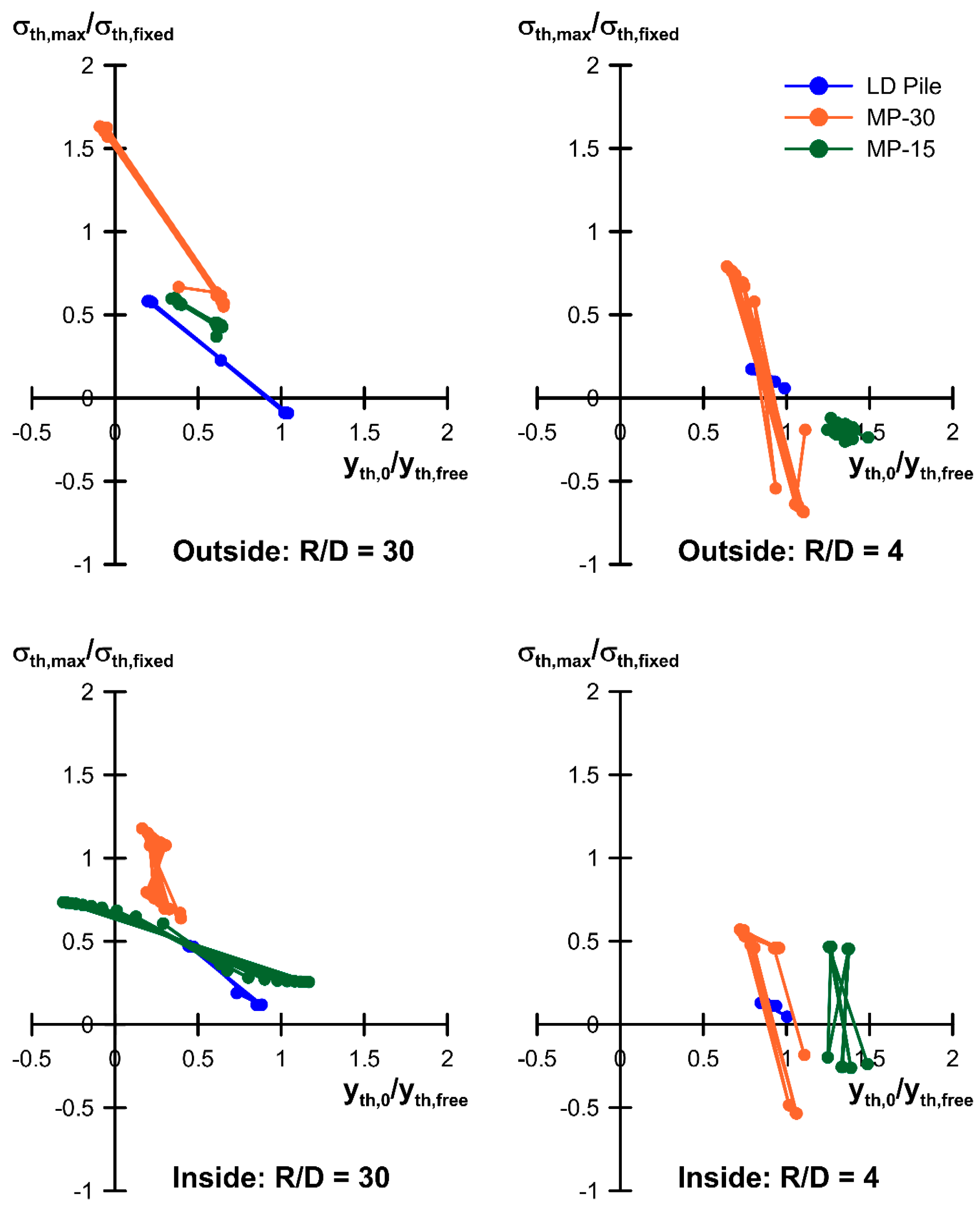
| Parameter | Unit | Micropile | Soil |
|---|---|---|---|
| Density, ρ | kg/m3 | 2500 | 1900 |
| Young’s modulus, E | MPa | 18,435 | Figure 1a |
| Poisson’s ratio, ν | - | 0.25 | 0.3 |
| Angle of shearing resistance | degrees | n/a | 38 |
| Cohesion, c | kPa | n/a | 0.1 |
| Interface angle of shearing resistance, δ | degrees | n/a | 32 |
| Interface friction coefficient, μ = tan | - | n/a | 0.624 |
| Thermal conductivity, k | W/m·K | 2 | 2 |
| Specific heat, c | J/kg·K | 940 | 800 |
| Linear coefficient of thermal expansion, α | με/K | 10 | 10 |
| Pile | Rc,u, kN | Rs,u, kN | Rb,u, kN | Fa, kN | FS-Global |
|---|---|---|---|---|---|
| MP-15 | 720 | 470 | 250 † | 235 | 3.1 |
| MP-30 | 1560 | 1530 | 30 ‡ | 765 | 2.0 |
| LD Pile | 18,410 | 6830 | 11,580 | 7280 | 2.5 |
| MP-30 | MP-15 | ||||
|---|---|---|---|---|---|
| R/D | Location | Average | Amplitude | Average | Amplitude |
| 30 | Head | −1.3 (36) | ±1.1 (31) | −0.22 (12) | ±0.92 (51) |
| Base | +0.04 (1) | ±0.21 (6) | −0.05 (3) | ±0.15 (8) | |
| 4 | Head | −0.74 (21) | ±3.2 (89) | −0.02 (1) | ±2.5 (140) |
| Base | +0.05 (1) | ±0.02 (1) | −0.08 (4) | ±0.45 (25) | |
| MP-30 | MP-15 | |||
|---|---|---|---|---|
| R/D | Average | Amplitude | Average | Amplitude |
| 30 | −1150 (52) | ±2480 (112) | −150 (7) | ±1160 (52) |
| 4 | −1580 (71) | ±170 (8) | 80 (4) | ±480 (22) |
| MP-30 | MP-15 | ||||
|---|---|---|---|---|---|
| R/D | Location | Average | Amplitude | Average | Amplitude |
| 30 | Head | 0.1 | 1.0 | +1.3 | 0.8 |
| Base | 0.2 | 0.2 | +0.9 | 0.2 | |
| 4 | Head | −0.5 | 3.4 | −0.0 | 2.4 |
| Base | −0.0 | 0.1 | −0.2 | 0.5 | |
| MP-30 | MP-15 | |||
|---|---|---|---|---|
| R/D | Average | Amplitude | Average | Amplitude |
| 30 | −330 | 2100 | +523 | 1100 |
| 4 | −1104 | 85 | +784 | 220 |
| MP-30 | |||||
| R/D | R,m | Outside | Inside | ||
| Injection | Extraction | Injection | Extraction | ||
| 30 | 6.0 | +23.7 | −24.8 | +18.4 | −31.7 |
| 8 | 1.6 | - | - | - | - |
| 4 | 0.8 | +16.8 | −16.6 | +13.3 | −16.9 |
| MP-15 | |||||
| R/D | R,m | Outside | Inside | ||
| Injection | Extraction | Injection | Extraction | ||
| 30 | 6.0 | +17.1 | −23.4 | +13.4 | −28.7 |
| 8 | 1.6 | +14.3 | −16.6 | +13.3 | −20.4 |
| 4 | 0.8 | +1.8 | −3.4 | +2.4 | −5.6 |
Disclaimer/Publisher’s Note: The statements, opinions and data contained in all publications are solely those of the individual author(s) and contributor(s) and not of MDPI and/or the editor(s). MDPI and/or the editor(s) disclaim responsibility for any injury to people or property resulting from any ideas, methods, instructions or products referred to in the content. |
© 2023 by the authors. Licensee MDPI, Basel, Switzerland. This article is an open access article distributed under the terms and conditions of the Creative Commons Attribution (CC BY) license (https://creativecommons.org/licenses/by/4.0/).
Share and Cite
Lupattelli, A.; Bourne-Webb, P.J.; Bodas Freitas, T.M.; Salciarini, D. A Numerical Study of the Behavior of Micropile Foundations under Cyclic Thermal Loading. Appl. Sci. 2023, 13, 9791. https://doi.org/10.3390/app13179791
Lupattelli A, Bourne-Webb PJ, Bodas Freitas TM, Salciarini D. A Numerical Study of the Behavior of Micropile Foundations under Cyclic Thermal Loading. Applied Sciences. 2023; 13(17):9791. https://doi.org/10.3390/app13179791
Chicago/Turabian StyleLupattelli, Arianna, Peter J. Bourne-Webb, Teresa M. Bodas Freitas, and Diana Salciarini. 2023. "A Numerical Study of the Behavior of Micropile Foundations under Cyclic Thermal Loading" Applied Sciences 13, no. 17: 9791. https://doi.org/10.3390/app13179791
APA StyleLupattelli, A., Bourne-Webb, P. J., Bodas Freitas, T. M., & Salciarini, D. (2023). A Numerical Study of the Behavior of Micropile Foundations under Cyclic Thermal Loading. Applied Sciences, 13(17), 9791. https://doi.org/10.3390/app13179791






